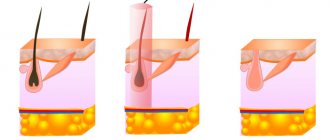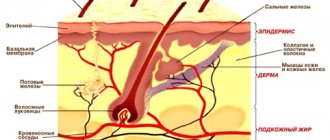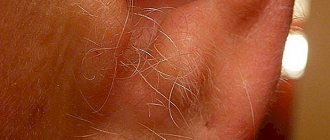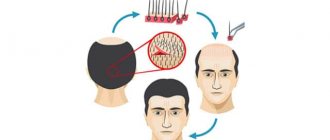Modern cosmetology offers several options for solving the problem of excess hair on the body. The most effective device that can easily cope with fluff, as well as hard stubble, is rightfully a laser. However, preparation for the procedure involves a number of nuances and subtleties. For those planning to undergo laser hair removal on the face for the first time, a logical question may arise: is it necessary to shave the face before laser hair removal, what length of hair should be left for hair removal. Let's try to figure this out!
Why shave your hair before laser hair removal?
Laser hair removal is an effective, but rather complex method of hair removal. During manipulation, the laser acts on the hair follicle, which contains a high-molecular pigment - melanin, melanin absorbs energy, heats up and after which the hair dies.
But it’s no secret to everyone that the longer the hair on the body, the worse the laser heats it. Therefore, the laser energy will not be able to get to the bulb.
Therefore, for a clear result, it is necessary to perform laser hair removal on short hairs.
Another important reason why you need to shave before laser hair removal is burns. For severe hairiness, the cosmetologist sets the maximum beam strength. Firstly, it will increase pain, but also cause a burn.
Thus, from the above, you need to shave before laser hair removal; there is no need to grow hair with this method of hair removal.
Duration of hair removal course depending on the affected area
As strange as it may sound, it is more difficult to remove hair on the face than, for example, on the legs. Depending on the zone, the number of procedures required to completely remove vegetation and the duration of the course itself vary. At the same time, the course is lengthened due to a larger number of procedures and due to different lengths of intervals between procedures.
It is necessary to plan a second and subsequent visits to a laser therapist when the hairs have grown sufficiently after the previous removal. The maximum effect of the procedure will be obtained when the maximum number of follicles enters the active growth phase, since it is these active follicles that are most sensitive to laser radiation.
On different parts of the body, the rate of activation of hair growth is different. The optimal frequency of sessions for removing mustaches above the upper lip is 4-5 weeks, for the forearms at least 6 weeks, for the legs 3 months. The more procedures are done within the course, the longer the interval may be required to activate the “dormant” follicles and move them into the active growth phase.
If a person epilates more often than necessary, there will not be much harm. But the benefit is also questionable, since this will only unreasonably increase the number of procedures required to completely remove hair from a problem area of the face or body.
The need for proper preparation
In order for hair removal to be productive and bring the desired result already at the first session, you need to prepare for laser manipulation correctly.
- Shave the affected area.
- Or grow your hair to the required 1 mm, this is only necessary if it was previously removed by wax or electrolysis.
- Refuse decorative cosmetics.
- Do not use other means for depilation (sugaring, waxing, epilator, etc. with this type of shaving, the hairs are cut off at the root)
- Do not take hormonal drugs, so as not to cause side effects in the body.
- It is not recommended to sunbathe under the sun or in a solarium, otherwise, under the influence of the laser, pigment spots may appear on dark skin.
- Two weeks before the procedure, avoid going to the pool and limit yourself from physical activity to completely eliminate unnecessary irritation from sweat and redness.
How often to do bikini hair removal
Bikini hair removal: how often to do it
We study how long epilation of the bikini area lasts
The bikini area is a special area. On the one hand, it is always in sight: a swimming pool, a sauna, a fitness room, a spa salon are just some of the cases when we have to undress in front of others. On the other hand, this is a rather intimate part of the body, the care of which is an important attribute of personal life. According to modern hygienic standards and concepts of beauty, keeping it in order and in a smooth condition is the responsibility of not only girls, but also men. However, some people are still embarrassed to talk about it openly.
High attention zone
Oddly enough, there are those who scrape themselves with a razor only because they cannot decide on another method of hair removal. This is partly due to reviews on forums, which contain rather contradictory information. In addition, beauty centers and professional hair removal studios, when describing their services, of course, only praise their methods. Finding independent information can sometimes be difficult.
The main question that interests everyone who wants to try a new method of hair removal in the intimate area is how long bikini hair removal lasts. My answer is: everything is individual and, first of all, depends on the chosen technique.
There is one thing in common here - each person's hair will grow at a different rate. This depends on the level of hormones that are responsible for the presence of hair on our body. It is impossible to make diagnoses in absentia; a specialist can give you an approximate guide at the first consultation. And you can only understand exactly when to do hair removal next time through personal experience.
How often do you have bikini hair removal?
Let's take a brief overview of the main methods of hair removal in the bikini area and take the average results for guidance.
Waxing
Minimum smoothness period
- 2 weeks.
Unlike shaving, hair is removed from the root, so it still takes time for it to grow to the surface. Some girls extend the “shelf life” of wasking by simply plucking out growing individual hairs with tweezers.
Sugar hair removal
Minimum smoothness period
– 2.5-3 weeks.
When sugaring, hairs are also removed from the roots mechanically. Unlike waxing, they are pulled out according to growth, so this type of hair removal is a little more effective. There is no risk of breaking off some of the hair at the base; therefore, there is no risk that some of them will grow back faster.
Electrolysis
Minimum smoothness period
– permanently as old hair is removed and new hair grows.
Electrolysis is perhaps the only method that has come close to actually understanding the word “forever.” Hair destroyed by electric current is no longer restored. However, this is quite painstaking and time-consuming work - the master must kill each hair one by one. It is not possible to completely clear the area in one session. And frankly, this is an activity for masochists. Bikini reacts quite sensitively even to painless diode hair removal, and even pain relief will not help here.
Photoepilation
Minimum smoothness period
- 1 month.
Compared to all other hardware methods, the course of photoepilation is the longest. You will have to go to the clinic at least 8-10 times, or even more. And in a few years the procedure will have to be repeated. Suitable only for people with dark hair and fair skin; other options will not be effective. The good news is that such hair removal is very inexpensive.
Elos hair removal
Minimum smoothness period
– 1-1.5 months.
Dual energy – radio and light – removes hair more effectively. Suitable for lighter and red hair. The course will consist of approximately 6-8 procedures.
Diode laser hair removal
Minimum smoothness period
– 1-2.5 months.
Suitable for any hair type on any skin. After the first session, “bald patches” will appear. To completely remove regrown hair from dormant hair follicles, you will have to use laser approximately 4-6 times. Each time there will be less hair, it will begin to turn into vellus hair, the interval between procedures will increase.
It is worth understanding that when we talk about “permanent removal,” we still mean “long-term removal.” It's difficult to predict how your hair will behave. Even after laser or elos hair removal, maintenance procedures may be needed 1-2 times a year to remove rare, sporadic hairs. However, one thing can be said with 100 percent certainty: there is no such thing as ineffective hair removal!
What should be the length of hair before epilation?
The optimal hair length when working with a laser is 1 mm. But some cosmetologists ask their clients to shave immediately before the procedure. This is not due to the desire of the specialist himself, but to the type of laser that will be used.
If you are not sure that you will properly treat the area with a razor, in some beauty studios cosmetologists offer this service - to treat the epilated area for an additional fee. Each beauty salon has its own price category for such a service.
Contraindications
Laser hair removal, like other types of hair removal, has contraindications. Before visiting a specialist, we recommend that you familiarize yourself with the list of contraindications:
- fresh tan on the skin;
- skin diseases in the acute stage or chronic;
- moles or saw marks on the body;
- ODS
- Oncological diseases;
- herpes;
- varicose veins - this ban mainly applies to the arms and legs;
- the body’s tendency to form keloid scars - tissue proliferation during injury;
- presence of burns;
- pregnancy period;
- breastfeeding;
- the presence of allergic reactions: rash, irritation;
- skin damage: abrasions and scratches.
- minors under 18 years of age.
Possible consequences
Cosmetologists claim that laser hair removal does not cause harm and does not cause severe pain. And possible negative factors after the laser can arise due to the stupidity of the client himself (did not adhere to contraindications) or a cosmetologist who is not sufficiently qualified. These include:
- skin burns;
- skin pigmentation;
- allergic reactions;
- inflammation of the hair follicle (folliculitis);
- herpetic rash;
- vision problems arise only when the patient does not wear special eye protection glasses intended for laser hair removal. Light rays negatively affect the retina of the eyeball.
- Swelling or redness after manipulation. They go away on their own within 24 hours, without pharmaceuticals. But this can also be avoided if you ask the specialist in advance to cool the skin before starting the procedure.
Skin care after hair removal
It is recommended to follow the following tips to care for your skin during sessions:
- hair removal after laser hair removal can only be done with a razor; it does not affect the follicle, which has a good effect on further sessions;
- for one day, try not to wet the treated area;
- do not go to the gym for the first 3 days;
- take only contrast showers for 12 days;
- do not apply scrubbing agents to the epilated area;
- If hair removal was carried out in the facial area, it is better to refrain from makeup for one day.
- It is recommended to apply Bepanten or children's cream, which has a softening effect, to the skin where there was laser exposure.
Preparation for the laser procedure is not difficult, the main thing is to listen to the advice and requirements of the cosmetologist. In this case, the smooth effect will last for many years.
Alexandrite laser
Veteran in the field of laser hair removal services. Its operating principle is based on the natural stone alexandrite. Thanks to its light-refractive properties, a beam is fixed, the length of which reaches 755 nm, and the diameter is about 1.8 cm. This laser is most suitable for removing dark hair on light skin. It is effective for hormonal imbalances or other disorders in the human body, when the hairs grow too dark and hard. But it is not sensitive to light, fine hairs. To remove them, alexandrite requires high radiation power and prolonged exposure, and this can cause burns. Its design has shortcomings. The impact head on the handle is open, so the light beam is scattered, reducing the effectiveness of the session. Accordingly, a longer exposure time is required.
Conclusion: The Alexandrite laser is optimal for removing dark-colored hair on fair skin (from types 1 to 3). But it is ineffective for fine, light, gray hairs.











